Jacketed Reactor Temperature Control Thermostat
In laboratories in the fields of chemistry, biology, medicine and other fields, various chemical reactions and biological experiments are often required. During these experiments, precise temperature control of the reactants is often required to ensure the accuracy and reliability of the experimental results. To meet this need, scientists designed a jacketed reactor temperature control thermostat.
Jacketed reactor temperature control thermostat is a fully automatic control equipment that integrates heating, cooling, temperature control and other functions. It can meet the temperature requirements of different applications and is efficient, stable and convenient. This kind of equipment is mainly used in the pharmaceutical, chemical, and laboratory industries to connect reactors for refrigeration and heating reactions, such as temperature rise and fall, and constant temperature control of glass reactors and metal reactors.
High-precision control of different temperatures is achieved through the technology of combining electric heater heating and compression refrigeration. When the temperature needs to be lowered, the compressor compresses the refrigerant and transfers it to the condenser, where it dissipates heat and converts it into low-temperature gas. The heat-carrying medium is then cooled down through a heat exchanger; when high temperature is required, the system uses electric heating to heat the heat-carrying medium. It is widely used in various fields, such as sample processing and material stability testing in laboratories; heating and cooling of reactors in the chemical industry; component testing and aging experiments in the electronics industry; temperature control of biomedical equipment, etc. Flexibility and reliability make it an indispensable device in many industries.
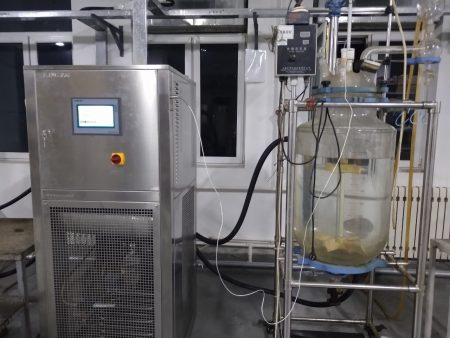
Characteristics of jacketed reactor temperature control thermostat
1. High precision: The use of advanced temperature control system can achieve precise control of the temperature in the reactor and ensure the accuracy of experimental results.
2. High efficiency: Using an efficient heating and cooling system, the set temperature can be reached quickly and the experimental cycle is shortened.
3. Safe and reliable: It has multiple safety protection functions, such as overheating protection, overload protection, etc., to ensure the safety of the experimental process.
4. Easy to operate: The user-friendly operation interface makes the operation simple and convenient, which greatly improves the experimental efficiency.
5. Energy saving and environmental protection: The use of energy-saving heating and cooling technology reduces energy consumption and reduces the impact on the environment.
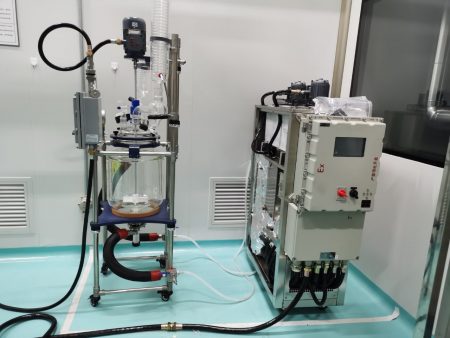
How to use jacketed reactor temperature control thermostat?
1. Place the stainless steel reactor and temperature control thermostat in a dry and ventilated place, and check whether the equipment is damaged or abnormal. Connect the devices according to the interface specifications. Make sure the discharge valve of the stainless steel reactor is closed.
2. Add thermal oil to the temperature control thermostat. Pay attention to the amount of thermal oil added.
3. Open the observation window of the reactor and put in the reaction materials. Make sure not to add more than 80% of capacity and close the lid. Pay attention to ensure that the steps of the PTFE cup and lid are clean, and no foreign matter is allowed.
4. Put the side with the steps downward into the bottom of the kettle body, and put the PTFE cup containing the reaction materials into the kettle body.
5. After screwing the cauldron cover all the way, retreat half a turn. It is strictly prohibited to use a large wrench to tighten. It is necessary to ensure that the power-assist gland returns to its original position.
6. Insert the stainless steel rod into the hole of the booster cover, hold the kettle body with your left hand, and tighten the stainless steel rod clockwise with your right hand. Do not use other power-assisted tools to prevent excessive pressure, otherwise the damage to the PTFE lining will be accelerated and the service life of the lining will be reduced.
7. When placing the reaction kettle inside the oven, there must be enough space inside so that the internal heating cycle can work normally. Close the oven door.
8. Turn on the power switch of the temperature control thermostat and perform heating or cooling operation according to the set temperature.
9. During the reaction process, pay close attention to the temperature changes in the reactor to ensure that the temperature is controlled within the set range.
10. After the reaction is completed, first turn off the power switch of the temperature control thermostat, then wait for the temperature to drop to a safe range before opening the reactor discharge valve and taking out the reaction materials.
Ofrecemos diseño y fabricación de sistemas completos de control de temperatura. Desde modelos estándar hasta productos personalizados completos de hasta 900 toneladas. Nos especializamos en el servicio al cliente y nos dedicamos a ayudar a cada cliente a tener el sistema de control de temperatura óptimo para su necesidad específica.
Ofrecemos soluciones personalizadas no estándar. Disponemos tanto de enfriadoras individuales como de unidades combinadas de refrigeración y calefacción.
Correo electrónico: info@lneya.com WeChat ID: +8615251628237 WhatsApp: +86 17851209193


Sistemas de refrigeración y calefacción (serie SUNDI)
Rango de control de temperatura: -120°C a +350°C
termostato de refrigeración y calefacción, ampliamente utilizado en diversas industrias.
| Temperatura | Serie -10 ~ +150°C | Serie -25 ~ +200°C | Serie -25 ~ +300°C | Serie -45 ~ +250°C | Serie -45 ~ +300°C | Serie -60 ~ +250°C | Serie -60 ~ +300°C | Serie -70 ~ +250°C | Serie -80 ~ +250°C | Serie -90 ~ +250°C | Serie -100 ~ +100°C | ||
| Capacidad de refrigeración | 1,5 ~ 15 kW | 1 ~ 200 kW | 1 ~ 200 kW | 0,45 ~ 200 kW | 0,9 ~ 25 kW | 0,25 ~ 60 kW | 0,75 ~ 25 kW | 0,4 ~ 15 kW | 0,3 ~ 80 kW | 0,2 ~ 80 kW | 0,45 ~ 80 kW | ||
| Nota: Se puede personalizar cualquier rango de temperatura de -150℃ ~ +350℃ y cualquier capacidad de refrigeración. | |||||||||||||
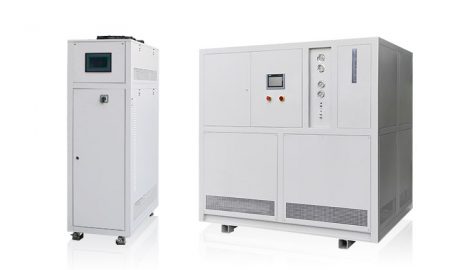
Sistemas de refrigeración y calefacción (serie WTD)
(Microcanales / reactores tubulares especializados)
Rango de control de temperatura: de -70°C a +300°C
Diseño especializado para microcanal (pequeña capacidad de retención de líquido, gran capacidad de intercambio de calor, sistema de circulación de alta caída de presión)
| Temperatura | -70°C ~ +300°C | -45°C ~ +250°C | -70°C ~ +200°C | ||||||
| Capacidad de refrigeración | 1,1 ~ 7,5 kW | 1,5 ~ 5,5 kW | 11 ~ 50kW | ||||||
| Nota: Se puede personalizar cualquier rango de temperatura de -150℃ ~ +350℃ y cualquier capacidad de refrigeración. | |||||||||

Circuladores de refrigeración y calefacción
Rango de control de temperatura: -45°C a +250°C
| Temperatura | Serie -25°C ~ +200°C | Serie -45°C ~ +250°C | |||||||
| Capacidad de refrigeración | 1 ~ 15 kW | 0,25 ~ 15 kW | |||||||
| Nota: Se puede personalizar cualquier rango de temperatura de -150℃ ~ +350℃ y cualquier capacidad de refrigeración. | |||||||||
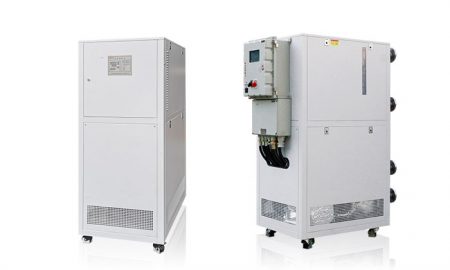
Termostatos de circulación
Rango de control de temperatura: +50°C a +300°C
Nota: La serie UC puede controlar la temperatura del medio de transferencia de calor. La serie UST no solo puede controlar la temperatura del medio de transferencia de calor, sino también la temperatura del material de reacción.
| Temperatura | +50°C ~ +170°C (serie UC) | +50°C ~ +300°C (serie UC) | +50°C ~ +300°C (serie UST) | ||||||
| Capacidad de calefacción | 5,5 ~ 15 kW | 3,5 ~ 130 kW | 3,5 ~ 95 kW | ||||||
| Nota: Se puede personalizar cualquier rango de temperatura de -150℃ ~ +350℃ y cualquier capacidad de refrigeración. | |||||||||
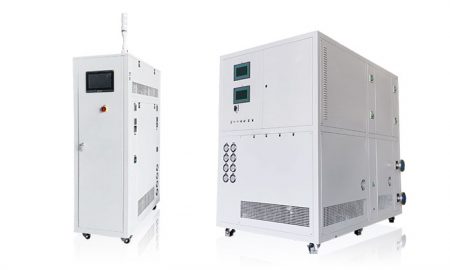
Serie TES
Rango de control de temperatura: -85°C a +250°C
| Temperatura | Serie -45°C ~ +250°C | Serie -85°C ~ +200°C | Serie -60°C ~ +200°C | ||||||
| Capacidad de refrigeración | 0,3 ~ 25 kW | 0,25 ~ 25 kW | 3 ~ 60kW | ||||||
| Nota: Se puede personalizar cualquier rango de temperatura de -150℃ ~ +350℃ y cualquier capacidad de refrigeración. | |||||||||

Serie LTS (Líquido fluorado)
Temperature Control Range: -80°C to +80°C
| Temperatura | Serie -20°C ~ +80°C | Serie -45°C ~ +80°C | Serie -60°C ~ +80°C | Serie -80°C ~ +80°C | |||||
| Control de caudal | 7 ~ 45 L/min | 7 ~ 45 L/min | 7 ~ 45 L/min | 7 ~ 45 L/min | |||||
| Nota: Se puede personalizar cualquier rango de temperatura de -150℃ ~ +350℃ y cualquier capacidad de refrigeración. | |||||||||
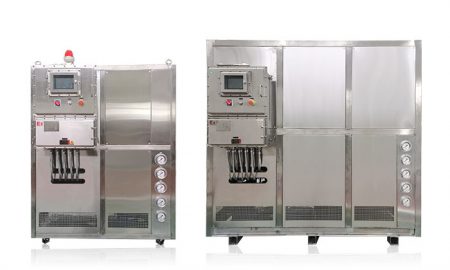
TCU Sistema de control de temperatura multirreactores
Rango de control de temperatura: -120°C a +250°C
| Temperatura | Serie -45°C ~ +250°C | Serie -120°C ~ +250°C | Sistema de control de temperatura personalizado | RT+10°C ~ +135°C | |||||
| Capacidad de calefacción | 25 ~ 80 kW | 25 ~ 80 kW | A medida | 25 ~ 300 kW | |||||
| Nota: Se puede personalizar cualquier rango de temperatura de -150℃ ~ +350℃ y cualquier capacidad de refrigeración. | |||||||||

Enfriadoras de recirculación / Criotermostatos
El enfriador puede utilizarse ampliamente en diversas industrias y laboratorios, y admite diseños personalizados.
| Temperatura | Serie -25°C ~ +30°C | Serie -45°C ~ +30°C | Serie -60°C ~ -20°C | Serie -80°C ~ -20°C | Serie -120°C ~ -70°C | ||||
| Capacidad de refrigeración | 0,8 ~ 30 kW | 0,75 ~ 12 kW | 0,4 ~ 6kW | 0,2 ~ 6kW | 0,3 ~ 5kW | ||||
| Nota: Se puede personalizar cualquier rango de temperatura de -150℃ ~ +350℃ y cualquier capacidad de refrigeración. | |||||||||
 Enfriadoras de agua / Enfriadoras pequeñas
Enfriadoras de agua / Enfriadoras pequeñas
El enfriador puede utilizarse ampliamente en diversas industrias y laboratorios, y admite diseños personalizados.
| Temperatura | -18°C ~ +30°C | Serie +5°C ~ +35°C | |||||||
| Capacidad de refrigeración | 0,35 ~ 0,9 kW | 1,8 ~ 50 kW | |||||||
| Nota: Se puede personalizar cualquier rango de temperatura de -150℃ ~ +350℃ y cualquier capacidad de refrigeración. | |||||||||

Refrigeradores de baja temperatura
Estamos especializados en la producción de refrigeradores de baja temperatura con un rango de control de temperatura de hasta -150°C, que pueden satisfacer las necesidades de refrigeración de diferentes industrias.
| Temperatura | Serie -25°C ~ -5°C | Serie -45°C ~ -10°C | Serie -60°C ~ -10°C | Serie -80°C ~ -30°C | Serie -110°C ~ -50°C | Serie -150°C ~ -110°C | |||
| Capacidad de refrigeración | 12 ~ 360 kW | 6 ~ 180 kW | 6 ~ 180 kW | 4 ~ 180kW | 2 ~ 120kW | 2,5 ~ 11 kW | |||
| Nota: Se puede personalizar cualquier rango de temperatura de -150℃ ~ +350℃ y cualquier capacidad de refrigeración. | |||||||||
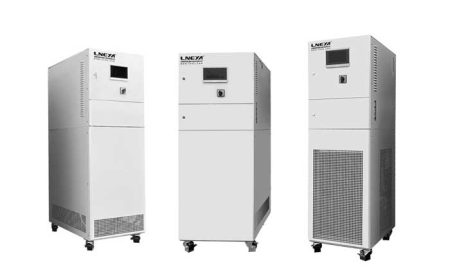
Refrigeradores de alta temperatura
El enfriador puede utilizarse ampliamente en diversas industrias y laboratorios, y admite diseños personalizados.
| Temperatura | +5°C ~ +40°C | -25°C ~ +40°C | -45°C ~ +40°C | -80°C ~ +80°C | -100°C ~ +80°C | ||||
| Capacidad de refrigeración | 6 ~ 40kW | 2 ~ 15kW | 1 ~ 8kW | 0,6 ~ 3 kW | 1,5 ~ 3 kW | ||||
| Nota: Se puede personalizar cualquier rango de temperatura de -150℃ ~ +350℃ y cualquier capacidad de refrigeración. | |||||||||
 LNEYA
LNEYA
 简体中文
简体中文


















































































